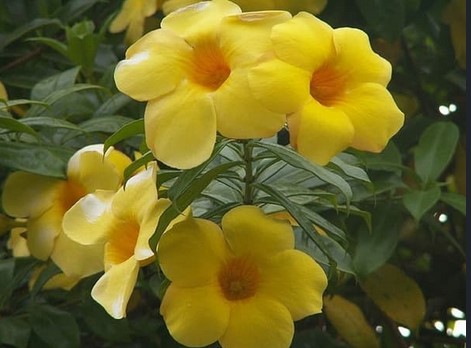If you are looking for a plant that can brighten your home garden with vibrant yellow flowers, go for Allamanda cathartica, a species of flowering plant of the Apocynaceae family. Allamanda cathartica produces fragrant flowers of deep golden yellow. It is popularly known as the golden trumpet, or common allamanda, grown in tropical locations.
With its trumpet-shaped yellow blooms and lush green foliage alamanda is a tropical plant that can transform any outdoor space into a tropical paradise. Though native to Brazil, this heat-loving plant thrives in warm climates and makes an excellent addition to gardens in zones 9-11. If you live in a suitable region incorporating alamanda into your landscape provides multiple benefits beyond beauty. Keep reading to learn why this plant is a natural solution for enhancing your garden.
Year-Round Yellow Blooms
One of the biggest perks of growing alamanda is the abundance of golden-yellow flowers it provides nearly year-round in frost-free climates. Each trumpet-shaped bloom measures 2-3 inches long and arrives in clusters at the ends of branching stems. Deadheading spent blooms encourages continual flowering. The bright golden hue of alamanda flowers enlivens any garden bed or landscape. Use them to complement bold reddish-orange plants like hibiscus or contrast with cool blue or purple flowers. The non-stop floral display will make your garden shine.
Attracts Pollinators
Like many flowering plants alamanda depends on visits from pollinating insects for reproduction. Its nectar-rich blooms draw in butterflies bees, hummingbirds, and other beneficial pollinators. By attracting these creatures, alamanda supports the whole garden ecosystem and biodiversity. Local pollinators will thank you for adding this flowering plant to your landscape. Observe hummingbirds darting around the blooms and butterflies sipping nectar from the bright flowers.
Provides Privacy and Security
With its tall, vining growth habit, alamanda makes a great privacy screen when trained up a trellis or lattice. You can create living fences or walls to block unsightly views without harsh lumber or stone barriers. The lush green foliage will conceal and beautify in one easy step. Alamanda’s thick growth also prevents trespassers from entering, making it useful for enhancing security around yards. For best results, plant in front of a sturdy trellis or similar support structure.
Shade and Temperature Reduction
The large, overlapping leaves of alamanda offer cooling shade when grown on a trellis, arbor, or pergola. As an added benefit, its transpiring foliage releases moisture into the surrounding air, resulting in a decrease in temperature. Alamanda makes an energy-efficient, natural alternative to a patio cover or awning. Train it over a seating area to enjoy time outdoors without overheating. Its tropical look adds beauty as it keeps you cooler.
Low Maintenance
Once established, alamanda requires minimal care to continue thriving season after season. It tolerates drought, high humidity, heat, and partial shade. Alamanda needs little pruning beyond removing spent blooms and shaping as desired. An occasional application of balanced fertilizer keeps it growing vigorously. For the busy gardener or those new to plants, alamanda is an ideal low-maintenance option. Set it and enjoy the benefits without hassle.
Versatile Uses
Valued for its non-stop flowers, alamanda brings beauty and versatility to gardens. Its vining habit lends well to training up supports like a pillar, obelisk, or mailbox post. Cascading varieties look lovely in hanging baskets. Use bushy types as vibrant specimen plants or foundational shrubs. Alamanda also thrives in patio containers where you can move the eye-catching blooms around. Add this plant to mixed beds and borders for pops of sunny color too.
Tropical Flair
Native to the tropics, alamanda evokes a resort-style, vacation vibe. Its big, shapely leaves, woody vines, abundant blooms, and overall lushness creates instant tropical flair. Use alamanda to give your landscape the ambience of a Hawaiian getaway or South American jungle retreat. Its exotic look transforms ordinary gardens into staycation destinations. Guests will feel transported when met with its tropical beauty.
Long Season of Interest
Unlike plants that only shine for a brief season, alamanda contributes beauty for many months of the year. It flowers nearly year-round where winters stay warm. Even when not in bloom, the glossy green foliage provides a lovely backdrop. Alamanda needs no special maintenance when not actively growing. For lasting curb appeal and extended color in the garden, few plants rival the longevity of interest alamanda provides.
Growing alamanda truly pays dividends with multiple benefits beyond beauty alone. Let this plant provide an easy, natural solution to boosting your garden’s aesthetics, plant diversity, comfort, and overall enjoyment. Bring the tropics home by incorporating alamanda into your outdoor living spaces today.

How to propagate the Allamanda plant?
The Allamanda plants can be propagated through seeds as well as stem-tip cuttings. Make sure the stem have three to four fully formed leaves at the tip.
How to plant Allamanda seeds?
You can plant the Allamanda seeds in a pot or in the ground in the garden area. Choose a pot with 7 inches of upper diameter and having drainage holes. Fill the container with well-drained soil.
Soak Allamanda seeds in water at room temperature for at least 24 hour. Using a file or sandpaper allows the seed’s shell to lightly break and allow water to seep into it.
Sow the seeds by making a hole in the soil of about one inch and cover it with soil. Apply water and maintain the moisture levels by checking if the topsoil becomes dry to touch. Seeds will begin to germinate in about a week.
Allamanda cathartica, a plant that grows in tropical and subtropical regions, is known to possess medicinal properties. The flower extracts have anti-inflammatory, antioxidant, antifungal, antibacterial, laxative, and invitro hepatoprotective properties. The leaf extract has antioxidant and anti-inflammatory benefits, antifertility potency in males, and antimicrobial action against various drug-resistant clinical pathogens.
